#iranian ancient artifact
Text
This ancient articraft was found!
TEHRAN – An engraved stone has recently been unearthed accidentally in the small village of Sahzab,East Azarbaijan province, northwest Iran,during a construction project,a senior police official in charge of protecting cultural heritage has said.
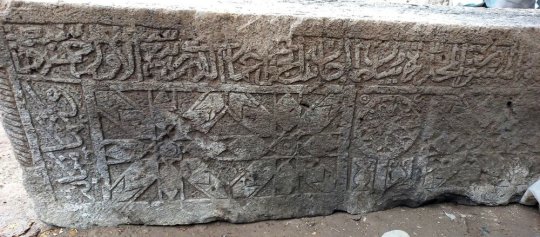
The locals soon informed authorities in charge of protecting the cultural heritage, and the stone was handed over to the village council for better protection, Kazem Dadashi explained on Tuesday.
Soaked in history and culture for millennia, Tabriz, which is the capital of East Azarbaijan, embraces several historical and religious sites, including Jameh Mosque of Tabriz and Arg of Tabriz, and UNESCO-registered Tabriz Historic Bazaar Complex to name a few. The city became the capital of the Mongol Il-Khan Mahmud Gazan (1295–1304) and his successor. Timur (Tamerlane), a Turkic conqueror, took it in 1392. Some decades later, the Kara Koyunlu Turkmen made it their capital. It was when the famous Blue Mosque was built in Tabriz.

The city retained its administrative status under the Safavid dynasty until 1548 when Shah Tahmasp I relocated his capital westward to Qazvin. During the next two centuries, Tabriz changed hands several times between Persia and the Ottoman Empire. During World War I, the city was temporarily occupied by Turkish and then Soviet troops.
source:https://www.tehrantimes.com/news/479181/Engraved-stone-discovered-accidentally-in-northwest-Iran
#Iran#iranian ancient artifact#engraved stones#East Azarbaijan#iran archaeology#archaelogy#Iran Tabriz#Safavid dynasty#UNESCO#police official in charge of protecting cultural heritage#culture#cultural heritage
1 note
·
View note
Text




Figurine of a Persian man 500-300 BCE
"The Persian nation contains a number of tribes as listed here. ... : the Pasargadae, Maraphii, and Maspii, upon which all the other tribes are dependent. Of these, the Pasargadae are the most distinguished; they contain the clan of the Achaemenids from which spring the Perseid kings. Other tribes are the Panthialaei, Derusiaei, Germanii, all of which are attached to the soil, the remainder—the Dai, Mardi, Dropici, Sagarti, being nomadic."
-Herodotus, The Histories, Book 1.101 & 125
#persian#persian history#iranian#achaemenid#antiquities#antiquity#statue#museums#artifacts#ancient history#history#pagan#paganism
88 notes
·
View notes
Photo

Ancient Iranian Carving Seized at a London Airport
An ancient sculpture illicitly carved from a rock relief in Iran will soon go on display at the British Museum before being repatriated to the National Museum in Tehran.
Carved in calcareous limestone, the sculpture depicts a standing male figure with an ornamental headdress. The piece likely hails from the 3rd century C.E. when the Sasanian Empire ruled greater Iran, according to the Guardian.
“It belongs to a period when Iran was the center of a powerful empire stretching from Syria to the Caucasus and Central Asia, and with its capital at Ctesiphon, south of present-day Baghdad,” St. John Simpson, an archaeologist and senior curator the British Museum’s department of the Middle East, told the paper. “The Sasanians were powerful rivals of Rome, and famous today for their fine silverwares and cut glass.”
The relief was seized at the Stansted airport outside of London, where border officers pulled the item aside because of its suspicious packaging—an unpadded, slapdash crate held together by nails. Inside was the carving, which had recently been excised with an angle grinder.
“We almost never come across a case of something being cut out of the ‘living rock,’” Simpson said. “That’s a level of brutalism that surpasses anything.”
Exactly where the carving came from remains a mystery, though context clues may help to narrow the list of potential locations. Roughly only 30 Sasanian rock reliefs are known to exist today, and almost all them came from the small Fars Province in southwest Iran.
Simpson suspects it “comes from somewhere in the Shiraz area” of the province. “Stylistically, it is similar to one known in the region,” he explained. “I think it probably is part of a big sequence. There might be more bits out there.”
The subject of the piece is similarly difficult to determine. “The lack of an inscription makes it impossible to identify the person depicted, but his dress and diademed headdress signifies him as a person of high rank,” the curator said. “His gesture of greeting and submission, with a raised bent forefinger, is a feature of Sasanian art when figures are in the presence of royalty, which suggests that this was part of a larger composition, with the king to the right and perhaps other figures behind.”
Interpol and the National Crime Agency have both investigated the object, but no arrests have yet been made. An internet auction site in the U.K. was listed as the package’s destination address, but the company claimed not to be expecting it.
Because of its poor padding, the relief broke in two pieces during transport. Conservators have since put it back together.
“The British Museum is committed to contributing to the preservation of cultural heritage in the U.K. and globally, partnering with law enforcement agencies to identify illicitly trafficked antiquities,” read a statement from the museum. “Objects seized in this way are brought to the British Museum for identification and cataloguing.”
The London institution obtained permission from the Iranian government to display the carving for three months. After that time, it will be repatriated to the National Museum in Tehran.
Simpson called the newly repaired piece “stunningly attractive,” before weighing in on its potential worth.
“The valuation could be anything, really. We’re talking £20 million to £30 million-plus,” ($25 million to $37 million) he said. “There’s never been anything like it on the market.”
By Taylor Dafoe.
#Ancient Iranian Carving Seized at a London Airport#the sasanian empire#rock releif#rock sculpture#ancient artifacts#archeology#archeolgst#history#history news#ancient history#ancient culture#ancient civilizations#stolen#looted
48 notes
·
View notes
Note
can I request Nyanlathotep x Reader where the reader doesn't believe in love and denies loving anyone.
Part 1! Because im taking far too long to write this.
It was not specified if the reader is meant to be human or an eldritch entity- nor if they're supposed to actually love or not so I'm going to take creative liberties with this, so if you meant something else send it again and ill re-write it! Thank you for being my very first request!
Warnings:
Spoilers for Sucker for love: date to die for.
Summary:
Nyanlathotep/Nyan Nyan x Reader who claims to not believe in any kind of love.

You were a success in life, richer than you could ever need, graduated to a good school and with heavy government influence under your belt; but most proudly you hold title to leadership to an ancient cult older than all mankind's civilized settlements across the world. The cult of Nyanlathotep was your only loyalty, tadked arranging your peons as the entity needed to whisper into the ears of leaders and stir fear into the population.... With the occational bloody sacrifice from time to time.
Yet none of of this success was by your own hands, Except... one thing. In the very begining as a dull eyed indoctrinated newcomer you were determined to carve your place in this cult, from the day you were accepted by the darkness you devoted your life to the faceless clawing chaos. The mindset you learned over time was to crush others before they crushed you, do anything to get to the top, kill if you needed to and always have eyes on your own back for anyone willing to betray you for the same reasons; This is how you came to lead the secret society.
Thinking about this you toy with the sparkling pendant around your neck, it is an Egyptian scarab that suspiciously looked like a golden pet collar bell to you... but it was an artifact theorized to be made by Nyanlathoteps hands and you wouldn't dare part with it for a simple comparison.
It was raining outside, pattering against the window of your high steel perch in your penthouse office making for a decent environment to self reflect but now that you're out of your own head you see something else has been with you, watching you like you had been watching the rain. For a solid uneasy minute you stared with a confused furrowed brow as a black cat is sat on the railing of the balcony; With such heavy rain you reasoned the cat must be miserable and against your better judgement pushed the door open a crack in case it wanted to come inside to warm itself.
" Just, don't piss on the carpet. " You spoke, turning away from the door to seat yourself at your desk, sighing at the papers scattered on it.
"I wouldn't dream of it, this is 17th century Iranian silk, is it not?"
For some reason you are about to open your mouth to answer when you register the fact you should be alone and quickly look up, finding no one there, not even the cat but strangely the door the cat came through is politely closed.
"You look so confused, does the pet not recognize its master? "
This time as the voice speaks it is close behind your head, but the primal prey-like dread holding your body stiff is familar yet far more intense than you had experienced within any ritual you have conducted. It feels like ice water is coursing through your blood and your mind is clawing at itself like a rabid animal; yet you find the syllables among the symptoms.
" -Nyanlathotep. "
You whisper as two large hands rest on your shoulders in a friendly manner. A deep chuckle rumbling from the entity's chest, amused by your frail humanity crumbling by her presence.
" So your soul recognizes what your eyes and ears do not... you've felt this energy before- but no where near my unfiltered presence, I'm sure. "
Taking a deep breath you steel your nerves and brace your very anatomy against imploding in the clawed hands of an ancient old god as you turn to get a look at Nyanlathotep. She isn't what you expected at all: a towering height threatening to hit the ceiling fixture, clad in white and gold Egyptian fashioned accessories. blue(I'm a tad color blind I think she's blue) fur not touched by the cold water of the rain outside... cat girl. She must have seen your expression as she tilts her head, amused, putting her hands together in a way where her fingers interlock with eachother.
" That face is unfit for greeting an old loved one.~ Not to mention you haven't offered me a drink or a place to sit which is bad hosting. "
This prompted you to stand and offer your office chair as a seat for the entity of your worship, not that it helped with her looming given it didn't come close to putting you two at eye level as she settled in your chair. " Not to be rude... but what do you want? " She made you uncomfortable as she mentioned your worship as love, pondering what angle the old god was attempting.
Nyanlathotep did not answer but opened one of the drawers of your desk, somehow pulling a kettle and a tea cup from inside despite you knowing there should only be files inside-
" Do I have to want something?" Nyanlathotep purred, pouring herself a cup of tea black as tar and just as goopy in texture... to you it looked disgusting, smelling similar to an electrical fire and plopping into the porcelain like partially solidified grease.
" Well I really doubt you'd come to me for a simple chat and a game of checkers- "
"I prefer chess." Nyanlathotep corrected, somehow sipping the dreadful 'tea' without a mouth or facial features to speak of "...but I will admit; you're right, there isn't much we could talk about I haven't heard before. Small talk is incredibly dull after the first few millenia of hearing the same thing again and again."
She took another sip of her concoction, keeping your attention in the moment of silence before she kept speaking. " It is within my interest that by your age you haven't found a mate yet. You know very well my most loyal followers are generational and your bloodline is a ticking clock at this rate."
" Not interested. " You rolled your eyes, crossing your arms like a defiant teenager, wrinkling your formal suit jacket with how tightly your arms are linked together.
"Are you one of those Ace of hearts, so to speak, Pet ?" She spoke casually but perhaps with an old term you haven't heard of- gesturing with her hand with uncertainty given gender and sexuality is a human concept as eldritch creatures do not abide by such things.
" I'm just not interested in relationships- People in general are a pain, Partners or friends, kids, any of them...! I don't do relationships. "
Scoffing Nyanlathotep finally makes eye contact with you, the gaze piercing your very soul, unamused by your claim. "How stoic of you but you neglect the known fact: humans are a social species of apes that require companionship to survive. " it felt as if you are being scolded like a child who needs to eat their vegetables for their own good... but you stood firm staring chaos in her single gold eye. As you both stared It did not escape her discernment that you were in a sorry state: Rude, unfriendly, unbrushed hair with only a cup of coffee in your gut and a chronically suffering insomniac- so it seemed accurate you didn't socialize.
"I'll fix you myself then. "
16 notes
·
View notes
Text
An Empire Across Three Continents
An Empire Across Three Continents
It was the ancient Roman Empire which was spread across three continents namely Europe,
Asia and Africa.
Exploring Historical Sources:
Historians are privileged to have a treasure trove of references that illuminate the stories of the Roman and Iranian Empires.
These sources can be broadly classified into three categories: texts, documents, and material remains.
Texts: The annals of history have been chronicled through a diverse range of textual sources.
Histories penned by contemporaries, often referred to as “annals,” provide a year-by-year narrative of the past.
Letters, speeches, treatises, laws, and other documents offer insights into the political, social, and legal landscapes of their time.
Documents: Documentary sources include inscriptions and documents preserved on papyrus scrolls.
These inscriptions, etched onto stone, provide glimpses into the language and customs of the era.
Papyrus, a reed-like plant grown along the banks of the Nile, served as a prevalent writing material.
Thousands of contracts, accounts, letters, and official documents have survived, revealing the daily life of ancient civilizations.
Material Remains: Archaeological discoveries contribute to our understanding of history through material remains.
These artifacts, unearthed through excavation and field surveys, offer a tangible connection to the past.
From buildings and monuments to pottery, coins, and even aerially photographed landscapes, these remnants provide insights into ancient cultures and societies.
Roman Empire | The Early Empire
The History of the Roman Empire can be divided into two clear-cut phases:
The Early Empire, covering its start until the third century, marks a crucial period when the fundamental principles of the Roman state were put in place.
The Late Empire, which emerged after the third century, represented a significant turning point marked by changing power dynamics and unforeseen challenges.
Difference between the Roman Empire and the Iranian Empire:
A significant contrast between the Roman and Iranian Empires can be found in their cultural makeup.
During this time, the Parthian and Sasanian dynasties, which held authority in Iran, predominantly ruled over the Iranian population.
The Roman Empire presented a rich tapestry of territories and cultures united under a common governmental structure.
In the Roman Empire, linguistic diversity was not just a facet of its identity but a reflection of its inclusive nature.
While many languages resonated within its borders, two languages stood out as the pillars of administration: Latin and Greek.
Latin and Greek were not merely languages of communication; they were the foundation upon which the administrative machinery of the empire was built.
While the upper class of the East expressed themselves fluently in Greek, their Western counterparts favored Latin.
A singular thread, however, bound all citizens – allegiance to a single emperor, transcending linguistic and geographical boundaries.
Latin and Greek were the administrative languages, creating a bridge between the diverse linguistic regions.
Click on the link to read more.
2 notes
·
View notes
Text
The Nation of Mitanni
Below is a painting of Mitanni soldiers!

Founded by the Indo-Iranians, the Mitanni Empire rested in northern Mesopotamia. Despite being recognized by historians as one of the members of the Club of Great Powers, a set of extremely powerful and technologically advanced nations that existed during Mitanni’s existence, Mitanni is typically forgotten or left out of the discussion. Perhaps this has something to do with existing simultaneously with ancient Egypt, one of the most known and celebrated civilizations in all of history. During its earlier years, the Mitanni nation would find itself in competition with Egypt (A Forgotten Empire). The New Kingdom of Egypt and Mitanni would combat one another over control of Alep, located between the Euphrates and Mediterranean. The Pharaoh at the time of the conflict, Thutmose III, managed to defeat the Mitanni army, claiming the land for Egypt. However, the assault on Minatti would not cease, as Egypt would continue to pummel outlying towns that belonged to the Minatti, humiliating and damaging the nation.
However, Egypt’s success is no sign of weakness for the Mitanni nation, as they also had their fair share of glory during this period. Following Mitanni’s defeat in its war with Egypt, Shaushtatar, the king of Mitanni during the end of 15th century B.C.E., managed to severely damage the capital of the Assyrian Empire and establish proper relations with Egypt. These relations are reflected through Mitanni’s part in the Amarna Letters (Amarna Letters). Despite their bad blood, the relationship between the two would be defined as something that was “brotherly”. The trading of artifacts, treasures, culture, and much more is recorded in the Amarna Letters, showing that mutual respect and trust existed between the two nations. However, as I write to you friend, I have speculation that this will not hold. As Mitanni’s existence as of late is attributed to Egyptian mercy. It is difficult to hold onto the belief that Egypt would hesitate in the assistance of Mitanni’s destruction if net growth for The New Kingdom was available.
2 notes
·
View notes
Text
In the eyes of Western art, what does Eastern jewelry look like?
In the early to mid-20th century, with the awakening of feminist consciousness, vanity cases became a fashionable symbol for elite women in high society. During this period, the Art Deco artistic decoration style was prevailing, and Cartier perfectly aligned with this trend. The Art Deco style emphasized symmetry, geometric shapes, luxurious materials, exotic elements, and unique designs—principles that resonated with Cartier's creative philosophy. After the Xinhai Revolution, a large number of precious artifacts from the Qing Dynasty flowed into countries like England and France, sparking a rapid increase in Europe's interest in Eastern art, culture, and design elements. This provided Cartier with an opportunity to blend Eastern styles, leading to the creation of some highly artistic Chinese-inspired vanity cases of significant cultural value.

An 18-karat gold, lacquer, mother-of-pearl, enamel, and gemstone-adorned Chinese-style vanity case by Cartier, Paris, circa 1927.
In a Sotheby's auction, this rectangular Chinese-style vanity case is equipped with a black lacquer base, adorned with tinted mother-of-pearl, creating a vibrant display of iridescence. The lid depicts a serendipitous encounter in a Chinese-style figurative garden, drawing inspiration from traditional Chinese brush painting techniques, utilizing pointillist perspective, and emphasizing detailed line work. The combination of 18-karat gold with black lacquer and mother-of-pearl allows the piece to showcase both luxury and dynamism through material juxtaposition. Decorated with geometric patterns, the piece seamlessly blends Chinese brush painting, mixed materials, and Art Deco style, expressing both artistic sensitivity and innovation while reflecting Cartier's contemporary interest in Chinese art and culture.
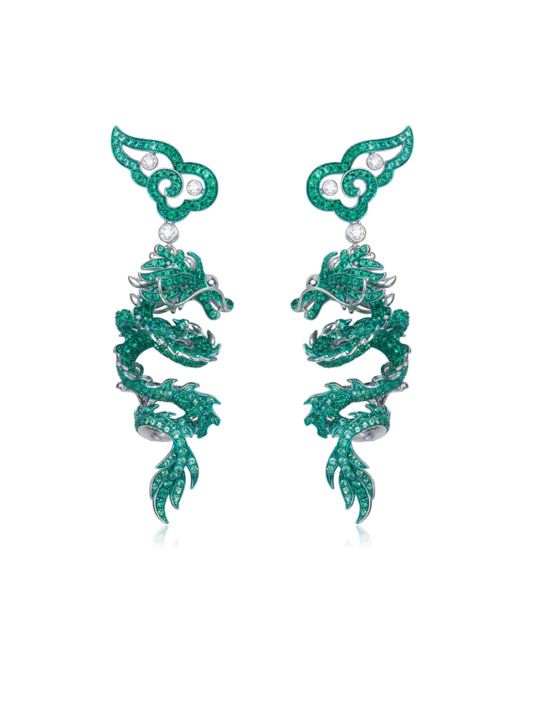
ChuCui Palace "Hidden Dragon" Earrings
Not only Cartier, but about 30 years later, ChuCui Palace, a high-end jewelry brand originating from a jewelry workshop in Rome, Italy, also focused on Chinese meticulous and freehand painting. In comparison to Cartier's use of meticulous style in the flat application of vanity cases, ChuCui Palace integrates meticulous style into three-dimensional high jewelry. Their piece "Hidden Dragon" earrings take inspiration from the traditional Eastern cultural totem - the dragon. Embracing the meticulous and detailed qualities advocated in meticulous painting, the earrings depict the Eastern azure dragon spiraling and ascending. Although static, the tension and elegance in the dynamic present are palpable. At the dragon's head, the piece refines the traditional Eastern ornamentation "cloud pattern," creating a contrast between simplicity and complexity, abstraction and concreteness. Using white diamonds as intervals, the dragon's body is as intricate as lines, with auspicious clouds intertwined as surfaces, highlighting the rhythmic sense of the piece. The work is dominated by blue gemstones and white diamonds, symbolizing the purity of traditional Chinese ink and color. Although employing Western techniques, the artistic expression is rooted in the logic of traditional Chinese painting, representing a three-dimensional reshaping of meticulous Chinese painting and a reinterpretation and creation of jewelry after in-depth research on meticulous Chinese painting.
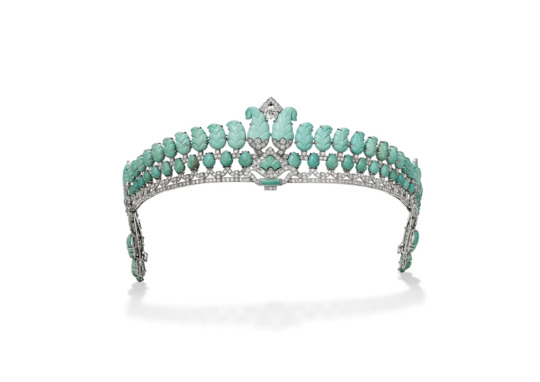
A high-end headdress in Persian style designed by Cartier in 1936.
In 1910, two exhibitions on Islamic art captured the attention of Louis Cartier. The exquisite and intricate miniature paintings, the vibrant clash of colors distinct from the Belle Époque's whites, and various geometric patterns left a profound impression on him. As a result, elements inspired by Islamic culture, such as patterns, motifs, and even architectural details, found their way into Cartier's high-end jewelry. In 1936, the brand drew inspiration from the bindings of ancient Iranian books from the pre-Islamic era. They created an exquisite headdress featuring a "Boteh" pattern crafted from turquoise, framed with diamonds in geometric patterns. This masterpiece not only embodies the distinct elements of Middle Eastern tradition and fashion but also exudes refined modernity. It allows people to see the details of cultural origins while conforming to contemporary trends. The geometric style of Islamic culture seamlessly integrates with the geometric elements of Art Deco, while the combination with turquoise brings a totemic exoticism, presenting cultural inclusivity, Middle Eastern culture's subtlety, and an aristocratic temperament.
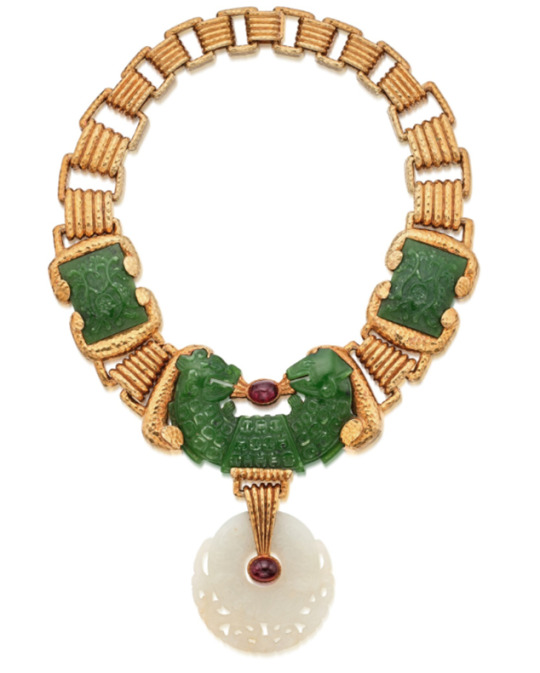
David Webb's Gold, Jade, and Ruby Necklace
In 1972, the American jewelry brand David Webb expressed its fascination with Chinese and Pre-Columbian cultures by creating a gold, jade, and ruby necklace. The combination of jade, gold, and rubies in the design creates a powerful sense of cultural fusion. The necklace features hammered gold patterns and a wide, bold size, exuding a primitive and wild charm. The intricate detailing of the Pre-Columbian motifs on the green jade plate engages in a dialogue with the Chinese-inspired openwork patterns on the light-colored white jade pendant. The interplay of various cultures, materials, and patterns showcases a strong sense of retro aesthetics and eclectic style.
In the collision of Eastern and Western cultures, jewelry design has emerged as exquisite works of art that transcend time and space. Brands such as Cartier, ChuCui Palace, and David Webb have absorbed elements from traditional Eastern cultures, delving into Islamic art and Persian patterns. Through diverse material combinations and innovative pattern inheritances, they have created a series of creative and uniquely styled jewelry pieces. These works not only continue traditions, allowing people to see the details of cultural origins, but also radiate new brilliance in a modern context, showcasing cultural inclusivity and continuous innovation in jewelry design. Each piece of jewelry tells a story, connecting the cultural heritage of East and West, serving as the intersection of art and fashion. These exquisite jewelry creations, like precious symbols of time, narrate profound emotions and historical legacies between different cultures, offering an artistic feast that spans civilizations.
0 notes
Video
the video is the english translation of the epic music Azhdaha Battle Theme 2nd phase - Genshin Impact OST by team of 待得一江烟雨 and yjhfyc-白翼龙
lyrics of the chorus are written in chuci楚辞 an anthology of Chinese poetry it speaks in Azhdaha's tone of the conflicting emotions of resentment, madness, sadness, anger, helplessness, sin and pain
this is the transliteration
suì yǔ xī hēi yì zhú
邃宇兮 黑翳逐
shān yě xī jiǒng bù chū
山野兮 窘步 出!
jūn cháng wéi xī guó huī wú
君常违兮 国隳芜
xù chóu yuàn zēng xī
蓄雠怨増欷
huáng huáng xī suǒ líng chí è tú guī xī
惶惶兮 索陵迟恶途 归兮!
chán shí luán yuè gǔ zhuǎn hū
巉石峦岳毂转乎
wàn chuān tuān liú tūn qióng lú
万川湍流吞穹庐
shān bēng yán zú
山崩岩崒
qiān gū ān chú
愆辜安除?
líng luò xī kùn wū dú
零落兮 困洿渎
jiāo jì xī qióng lù
浇季兮 穷路
lín jùn mào xī yǎn shū tú
林峻茂兮 掩殊途
shěn xíng mí yán zhù yuǎn xī shān qióng fù
审行迷延伫远兮 山穹覆
here is the official translation
"(Long ago) In the field of stars, Expelling the dark shadows"
"(Now) Lost in the mountains and wilderness, with no way to go"
"Show yourself!"
"Since you left, this country has fallen into A terrible state"
"Hatred, sorrow, and grief accumulate day after day"
"Panicking and knowing where to go. I embark on the treacherous journey ahead"
"It's time to return"
"The steep rocks and mountains withstood the test of time"
"Thousand of rivers rush rapidly, seemingly swallowing the sky"
"(But even if) Mountains fall and earth tremors"
"How can the evil (which caused all this) be eradicated?"
"(Fate) Lonely and wandering, trapped in such a harsh place"
"There's no way out of this miserable generation"
"The mountains are precipitous and lush, hiding the path that diverged (between you and me)"
"Recounting how i had lost my way and wandered away from you, engulfed by the shadow of a mountain ridge"
Full music by Yu-Peng Chen HOYO-MiX
youtube
According to The Birth of a Dragon: A Behind the Scenes Look At the Creation of Azhdaha released by the official account, Azhdaha's name comes from Iranian culture, and its image is inspired by dragon related artifacts from ancient China during the period from Western Zhou to Han Dynasty, as well as stecossaurs.
#music#china#genshin impact#azhdaha#zhongli#bgm#ost#video#chineseculture#the bytes and syllables of chuci are very concise one word can convey a very rich meaning#so it is very suitable for chanting#the lyrics are highly praised by the players because it is very well written#combined with the plot it is very touching#the lyricist must have an in-depth study of ancient Chinese and have very professional literary skills#already a scholar level#also erhu is indeed as the soul of chinese folk music#its bleakness and beauty is so unique#whenever you hear it you recognize in one second
185 notes
·
View notes
Text
“Besides Thracians, Greeks encountered many other tattooed people among their neighbors around the Black Sea and in Pontus, major Amazon strongholds. Numerous authors reported tattooing among Scythians. Hippocrates, for example, remarked that the Scythian nomads “branded” figures on their shoulders, arms, chests, and thighs to “instill strength and courage,” suggesting a magical function of tattoos. Herodotus wrote that the Thracians thought plain skin signaled a lack of identity. Elaborate tattoos were considered beauty marks of nobility for both men and women in Thrace; even ordinary folk had a few small tattoos.
Some four hundred years after Herodotus, the Greek orator Dio Chrysostom remarked that the women of Thrace were still covering themselves with tattoos as marks of high social standing. Herodotus also described the tattoos of the Iranian-speaking Scythian-Thracian people called the Agathyrsi. According to a story he heard in Pontus, the Agathyrsi claimed descent from a Scythian woman and Heracles. The Agathyrsi were one of the tribes that had repelled Darius I of Persia (sixth century BC). Later (fourth century BC) they would migrate north to the Sarmatian steppes. Agathyrsi women especially favored tattoos, noted Herodotus. The higher their status, the larger, more richly detailed and colorful were their skin designs.
Ammianus Marcellinus (fourth century AD) reported that Agathyrsi tattoos were checkered designs in blue-black ink. When the Greek general and historian Xenophon led his army across Pontus (ca. 400 BC), the land of the Amazons, he observed that the skin of the men and women and children of the Mossynoeci tribe was covered with colorful tattoos of flowers. Pomponius Mela also reported that these people completely marked their entire bodies with tattoos. The Sarmatians, strongly associated with Amazons, received their first tattoos as children, according to Sextus Empiricus and Pliny; Pliny also reported that among Sarmatians, Dacians, and Britons, the women “wrote on their own bodies.”
Clearchus of Soli explicitly stated that Scythian women—the historical counterparts of Amazons—taught the art of tattooing to Thracian women who lived on the northwestern frontiers of Scythia. A Greek philosopher who traveled widely and wrote extensively about Thrace, Clearchus reported that Scythian women “used to decorate the Thracian women all over their bodies, using the tongues of their belt buckles (or pins of brooches) as needles.” After several generations, Thracian women began to add their own embellishments and other designs to the Scythian motifs.
Ancient accounts of tattooing by the Thracians, Scythians, Sarmatians, Agathyrsi, Mossynoecians of Pontus, Illyrians, Dacians, Geloni, and Iaopodes are compelling evidence that many of the women known as Amazons also practiced tattooing. Because the Greeks thought of tattoos as marks of degradation instead of signs of nobility, courage, and beauty, they sought to explain why women would choose to endure pain to decorate their bodies with indelible designs. Clearchus implied that tattoos were initially inflicted violently by Scythian women and then later embraced by Thracian women, who cleverly transformed “shameful” tattoos into lovely body ornaments.
Scythians did invade parts of Thrace, intermarried with Thracians, and influenced Thracian culture. Forcible tattooing of captives is certainly attested in ancient and modern times. But sharing tattoo motifs and techniques among cultures is also well known. What was the historical context of Clearchus’s report? Did some Scythian women once tattoo captive Thracian women? Or did they simply teach their Thracian neighbors how to tattoo? Other literary evidence for tattooing customs among steppe cultures comes from sources far removed from Greece.
…Tattooing is often associated with women in many of the ancient and modern examples. Tattooed Thracian men are not represented in Greek art, although Herodotus, Xenophon, Cicero, and others included men in their descriptions of tattooing. Archaeological evidence hints that female tattooing may have an extremely ancient history across Thrace and western Scythia. Neolithic sites of Cucuteni culture (4800–3000 BC) in the forest steppes of Romania and southwestern Ukraine have yielded hundreds of clay female figurines inscribed with lines and spirals; some scholars believe they represent tattoos. Along with the clay figurines, archaeologists also unearth caches of inscribed horse phalanges (toe bones).
The bones’ natural shape suggests a nude female torso; the distal condyles resemble breasts or shoulders. The four-inch-long bones were smoothed and polished and then incised with geometric designs (sometimes nipples were indicated). One obvious interpretation of the decorations is that they signified tattoos. Similar incised figurines have been discovered at sites of the same date near Lykastia, Pontus (a region known for women warriors, according to Apollonius of Rhodes; chapter 10). Painted spiral patterns also decorate similar figures of the same time frame in Turkmenistan. Yet another region long associated with Amazons, Gobustan in Azerbaijan, has about seven thousand ancient petroglyphs (Neolithic-Bronze Age) depicting symbols, animals, and people armed with bows, axes, and spears, some riding horses.
One composition shows eight females (carrying bows?) whose body markings could indicate tattoos. The curious practice of creating decorated female torsos from horse bones was very widespread, from Romania and Pontus to Kazakhstan, the heart of ancient Scythia. Troves of these incised female forms, along with vast collections of horse remains, were recently excavated from sites of the Botai culture of northern Kazakhstan (ca. 3700–3100 BC). These seminomadic people were among the first to domesticate horses. The archaeological evidence shows that they also made human skulls into bowls, drank fermented mare’s milk (koumiss; chapter 9), and apparently enjoyed a high level of gender equality, prominent features of Scythian-Amazon life reported by Herodotus and others.
The archaeologists interpret the geometric markings on the Botai horse-bone figures as some of the earliest representations of ancient clothing construction. Based on their assumption that the marks on the Neolithic female forms, incised with tattoo-like designs, indicate stitching, belts, and necklines of clothing, the archaeologists suggest that Botai horsewomen wore stiff, loose-fitting, ankle length dresses of homespun hemp. If the incisions on the torsos do represent clothing, a close-fitting tunic might be indicated, since nothing below the hips is shown. (Wide skirts could be modified into trouser-like garments for riding; see below and chapter 12).
An alternative possibility, not mentioned by the archaeologists, is that the lines on some of the female torso shapes represent tattoos. As we have seen, it can be difficult to distinguish tattoos or body paintings from garments in ancient artifacts. The Botai patterns that the archaeologists interpret as stitched seams call to mind the ladder/fence tattoo designs that mimic the seams of sleeves along the edges of the bare arms of Thracian women on Greek vases. Similar stitching/seam patterns appear on nude female clay figures from Turkmenistan (2600– 2100 BC); they also appear on Bosnian and Kurdish women’s arm tattoos.
The deliberately smoothed surface of the horse bone to make it look more like a shapely female torso—sometimes with dots around the pubic region or nipples—conveys an impression of nudity. If these objects had some ritual purpose, as argued by the archaeologists, a naked female form seems more appropriate and powerful than a clothed one. It is interesting that the dashes, zigzags, cross-hatchings, ladders, triangles, and chevrons prefigure some of the patterns on both the exotic attire of Amazons and Thracian tattoos in vase paintings. At any rate, the mysterious female forms created from horse bones point to a strong, very ancient relationship between horses and women in Thracian-Scythian lands.
Tattooing traditions among women persist in many locales associated with ancient Amazons, both mythic and historical. As in the Balkans, in Dagestan between the Caucasus and Caspian Sea (where the Amazon queen Marpesia was active) women still tattoo their arms with geometric symbols. Their traditional marks include dots (coded love messages), moons (for happiness and luck), and bird-tracks (thought to make a girl a fast runner). Ornamental tattooing is also practiced by Aghach Eris women, Turki-Persian-speaking nomads of Iran, and by Turkmen people. Kurdish women of northern Iraq and the southern Caucasus, thought to be descendants of Bronze Age Hurrians who spoke a Caucasian language, still tattoo themselves with rayed circles and half-circles, dots, chevrons, and stitch, fence, and comb shapes.
On his journey across Central Asia in the thirteenth century Marco Polo described how women and men used needles and ink to engrave the “strange likenesses” of raptors, lions, and dragons on their bodies. In many cultures, tattoo designs are repeated in clothing, textiles, and other objects, which helps explain the similarity of motifs on barbarian clothing and the skin of Thracians, Scythians, and Amazons in ancient Greek art. Some modern scholars argue that Athenian vase painters drew tattoos on Thracian women to brand them as savage “barbarians” who failed to conform to the classical Greek feminine ideal.
Likewise, the exuberantly patterned clothing worn by Amazons and Scythians in Greek art is thought to be an artistic convention for signaling “Otherness.” But the artfully rendered tattoos of the Thracian women on Greek vases were grounded in fact: such tattoos were a daily sight in Athens. The specific forms of the Thracian tattoos—repeated in the patterns worn by Amazons—were not simply invented by Greek artists in pottery workshops. The same abstract and animal designs appear on leather, wood, and golden objects and textiles excavated from tombs of Thrace and Scythia, and they also match traditional tattoo motifs on once-living inhabitants of ancient Amazonian territories.
Tattooing methods, like tattoo motifs, are extraordinarily conservative, unchanged over millennia (needles, pigments, and stencils have been recovered from Scythian graves). First the design was drawn or traced on the skin. A bundle of three to seven needles punctured the design into the skin and then pigment was rubbed in (carbon paste from charcoal ash). The paste was variously mixed with other substances, such as tallow, honey, wild berry juice or indigo (for blue pigment), sap, ox bile (to set the dye), saliva, or the breast milk of a woman nursing an infant girl or, in the Balkans, a son. The colorful flower tattoos of the Mossynoeci of Pontus suggest that colored pigments were known in antiquity. Tattooing equipment was recently excavated in 2013, next to a skeleton dressed in a richly decorated tunic and trousers, buried with lavish grave goods in a Sarmatian-Scythian kurgan on the steppes between the Ural Mountains and the Caspian Sea.
The tattoo kit consisted of pigments and spoons for mixing them on two stone palettes, gilded iron needles, and other tools. Many Scythian burials contain similar items, which had been mistaken for women’s cosmetics by earlier archaeologists. Plentiful evidence makes it safe to assume that Greeks were familiar with tattooing practices of Scythian and related Eurasian tribes, and that they would expect the women they called Amazons to wear inked designs. The most powerful proof is frozen in time—inscribed on the skin of mummified bodies recovered from icy graves in the Altai. Thanks to some extraordinary recent discoveries, we now know precisely what sort of tattoos were worn by real horsewomen of the steppes.”
- Adrienne Mayor, “Tattooed Amazons.” in The Amazons: Lives and Legends of Warrior Women across the Ancient World
44 notes
·
View notes
Text
A Good Omen
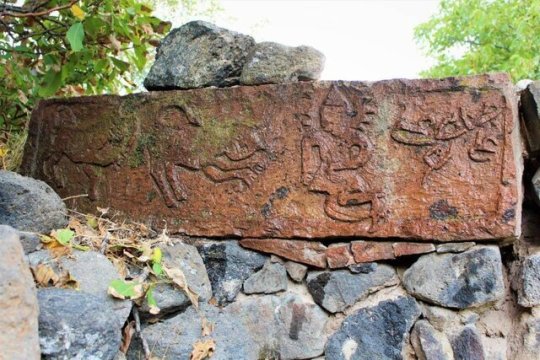
Just the same an ancient persian sword was found in Krasnodar(see in a old post of mine https://ashitakaxsan.tumblr.com/post/698956033583972352/ancient-iranian-sword-unearthed-in-russia )now an other significant discovery opens up to us a perspective,to what worthy events have taken place long ago.
Namely iranian Inscriptions were discovered in a ruined mosque,in a small village in Armenia,that can help trace the history of the Iranian lion symbol back several hundred years,it’s what a member of Iran’s Research Institute of Cultural Heritage and Tourism has said.
It turns out that Armenian inscriptions place the history of the lion symbol in Iranian petroglyphs 600 years earlier than archaeologists originally thought, ISNA quoted Morteza Rezvanfar as saying on Friday.
In one of these Persian inscriptions, a lion is engraved with a sword in hand next to the name of Imam Ali (AS), he added.
According to historical documents, this motif dates back to the time of the Qajar king Fath Ali Shah who reigned from 1797 to 1834, but these newly discovered inscriptions may push that date back over 600 years, he explained.
In addition to the lion and sun symbol, which dates back thousands of years, the first image of a lion holding a sword in inscriptions discovered in Iran, dates back to Qajar-era (1789-1925), and before that, the lion symbol have always had its feet on the ground, he noted.
Iran, also known as Persia, historic region of southwestern Asia that is only roughly coterminous with modern Iran. The term Persia was used for centuries, chiefly in the West, to designate those regions where the Persian language and culture predominated, but it more correctly refers to a region of southern Iran formerly known as Persis, alternatively as Pars or Parsa, modern Fars.
My little say:
The nation of Persia,are the real natives of the land,the Persians are the Ancestores of todays Iranians,their origin has nothing to do with “Indo-European”,because the Indo-European theory is a severe fabrication made by weird Western intellectuals. As the iranian artifact found there this just says:if any nasty entity attempts there to pull something it will find Iran opposing,to any scheme.
Source:https://www.tehrantimes.com/news/484342/Inscriptions-found-in-Armenia-may-push-back-history-of-Iran-s
#Iran#Iranian archaeologists#Iranian petroglyphs#Armenia#Ancient Persia#lion symbol of Iran#Tehran#iranian artifacts in Caucasus#Caucasus#Hayastan#Indoeuropean hoax#Tehrantimes
1 note
·
View note
Text

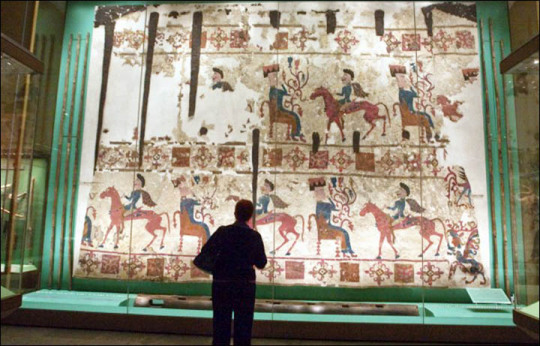
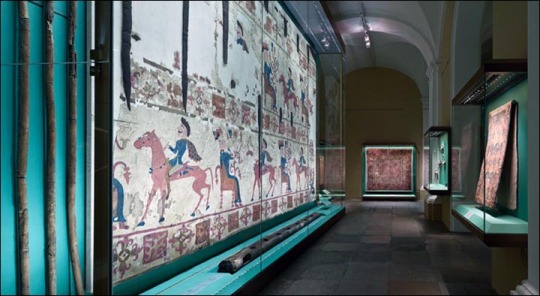

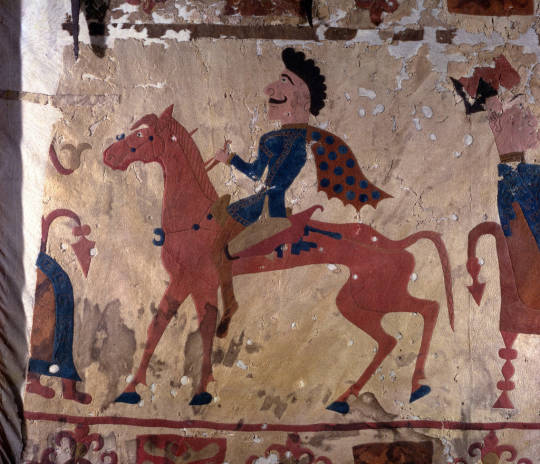
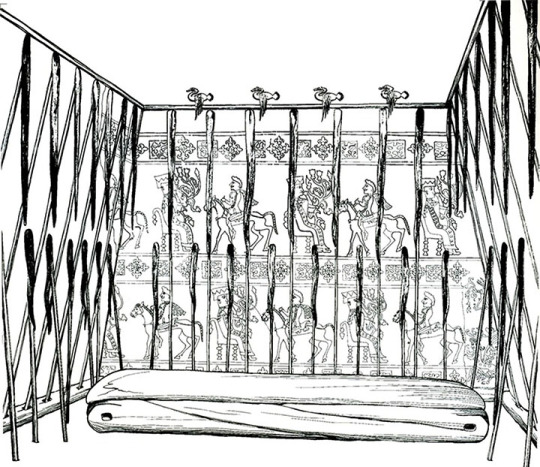
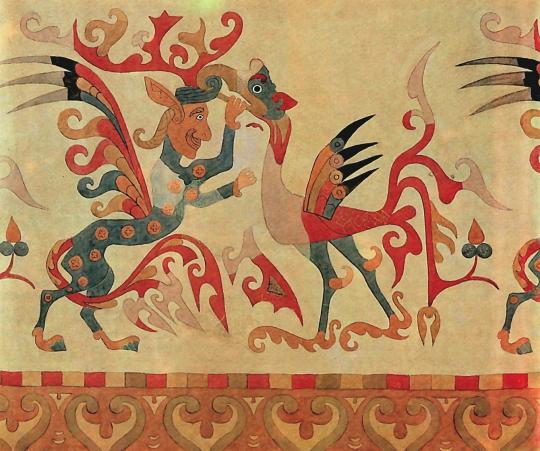
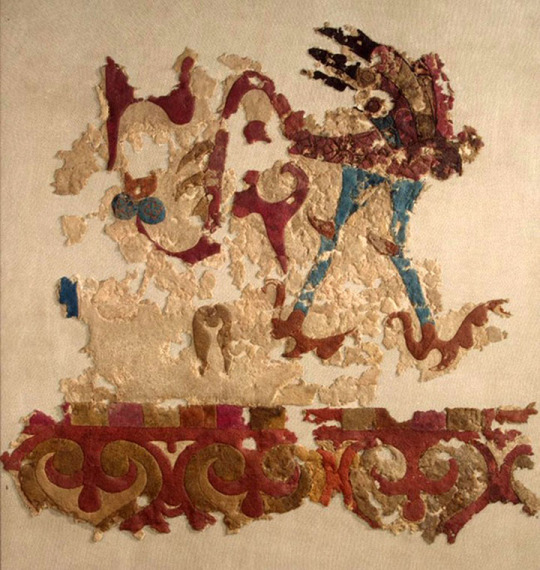
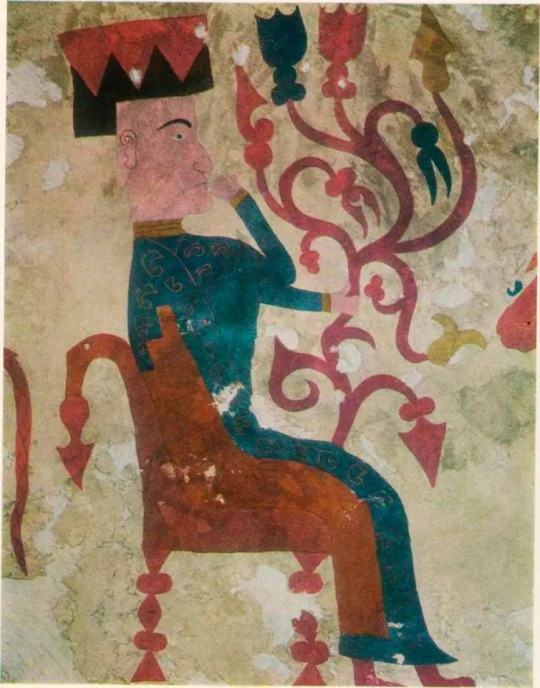
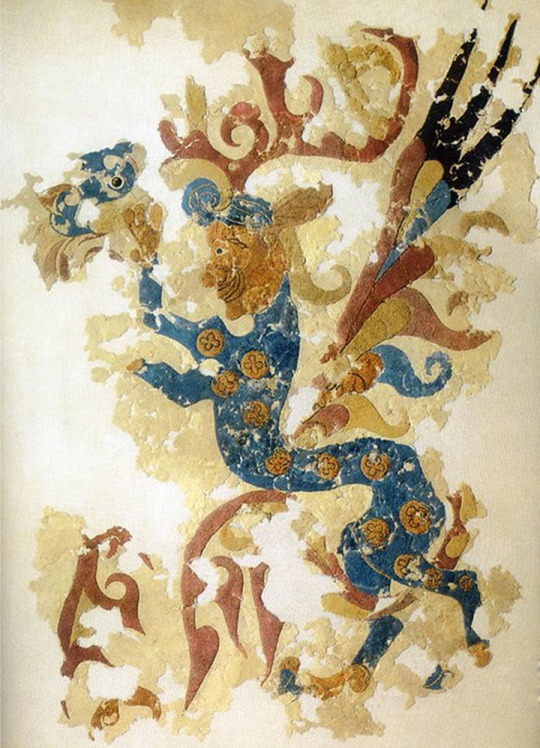
Goddess Tabiti and Scythian rider, tapestry from the Fifth Pazyryk Kurgan 3rd C. BCE. She holds a plant in her hands, possibly representing a tree of life.
"The large felt rug was neatly rolled up with long thin poles inside. The base of the rug (a cloth of thin white felt, 3mm thick and about 30 sq.m. in area) was covered with colored felt appliqués. The figures, painted with vegetable dyes, are sewn to the rug with twisted sinewy thread.
In two wide friezes, the same scene is repeated many times: a female character in luxurious attire sits on a throne, holding a branch of a mythical plant; a mounted warrior—also in decorated attire, with a compound bow in a harness suspended from his belt—approaches her. In all the scenes the figures are similar, but not identical, demonstrating that they were not made from a single template.
This plot has a pre-Asiatic origin; judging by analogical artifacts, it was also known to the Black Sea Scythians and Sarmatians. It is usually interpreted as an investiture scene where a certain Goddess “hands over” power to a leader.
Fragments of a second, not preserved rug with images of two mythical creatures were sewn on the side of a large rug in ancient times. One was a hind-footed creature with a lion’s body, wings, and a human head with stylized horns (a sphinx). The tail and wing feathers, as well as the clawed feet with spurs, are preserved from the other character. The original composition of the second rug can be read by correlating the fragments sewn into the large rug with the scraps of drapery that survived in the burial chamber; only the sphinx has been fully restored. The second character is a bird with a large hooked beak (conventionally called a phoenix).
The phoenix clutches at the head of the sphinx, which in turn grabs his opponent by the beak. This composition, like the “investiture scene” from the large rug, has early analogues in Western Asia and the Middle East, and was repeated exactly the same way many times. Indeed, the image on the fragmented rug probably originally had the same frieze composition as the large one.
Apparently, the large rug was stretched over the poles that were found wrapped in it, creating a funeral “tent” where the body of the deceased may have been displayed for some farewell ceremonies. It is also possible that the “tent” was placed over the burial chamber and served as a temporary ground structure until the mound was erected over the burial. The fact that the rug had to be repaired and remade using fragments of the second rug proves that these rugs were not made specifically for the funeral but earlier. It follows that the subjects of the images on them should not be interpreted as necessarily related to the burial.
It is interesting to compare the riders depicted on the pile rug with the mounted warrior on the repeated scene of the felt rug.
The carpet-makers of Trans-Asia depicted riders on the felt carpet who were not yet using saddles (on the backs of their horses were archaic large saddlecloth with breastplates), while the saddles depicted on the felt carpet are specially made objects that look similar to those among the Pazyryk finds. The nomads were always somewhat ahead of their sedentary neighbors in terms of horseback riding (and often also weaponry) but borrowed from them for luxury items. For example, in the fifth kurgan were found five cheprak (saddlecloths), two of which are decorated with imported fabrics. Nomads typically did not use cheprak; their presence here is most likely evidence of a temporary strengthening of Pazyryk relations with the Iranian world in the mid-third century BC."
-taken from VoicesOnCentralAsia
#tabiti#scythian#pazyryk#hestia#tapestry#artifacts#antiquities#museums#ancient art#pagan#3rd century bce
69 notes
·
View notes
Photo
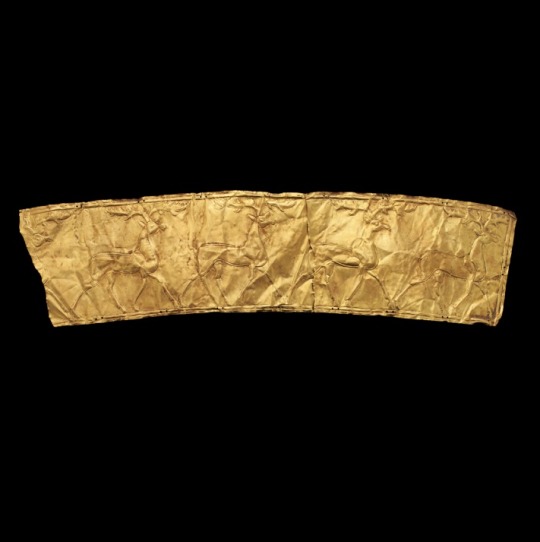
A WESTERN IRANIAN GOLD PLAQUE
CIRCA 7TH CENTURY B.C.
10 5⁄8 in. (27 cm.) long.
Formed of hammered sheet gold, this long plaque is ornamented in repoussé and enhanced by incision with a frieze of stags walking to the right. There are perforations along the edges for attachment, perhaps to leather or cloth. These two joining fragments are thought to be part of the Ziwiye Treasure, a hoard of ancient objects in precious metal and other materials found on the ancient citadel on Ziwiye in Kurdestan, east of Saqqiz in Northwestern Iran, now widely dispersed in museum and private collections.
#A WESTERN IRANIAN GOLD PLAQUE#CIRCA 7TH CENTURY B.C.#archeology#archeolgst#treasure#gold#gold jewelry#ancient artifacts#history#history news#ancient history#ancient culture#ancient civilizations
15 notes
·
View notes
Photo

𝗔 𝗬𝗲𝗮𝗿 𝗶𝗻 𝗙𝗮𝗶𝘁𝗵, 𝗗𝗮𝘆 𝟳𝟰: 𝗣𝗿𝗼𝘁𝗼-𝗜𝗻𝗱𝗼-𝗘𝘂𝗿𝗼𝗽𝗲𝗮𝗻 𝗥𝗲𝗹𝗶𝗴𝗶𝗼𝗻
The Proto-Indo-European (PIE) religion is the proposed reconstruction of the beliefs held by the ancestral Proto-Indo-Europeans. Though we lack direct evidence for it, the echoes found across the historical record and in modern Indo-European peoples enable us to make strong conjectures about this ancient faith. Names and words in PIE are generally prefixed with a “*-“ to represent their theoretical status.
𝗪𝗵𝗼 𝗧𝗵𝗲𝘆 𝗪𝗲𝗿𝗲 𝗮𝗻𝗱 𝗛𝗼𝘄 𝗪𝗲 𝗞𝗻𝗼𝘄
The Proto-Indo-Europeans lived as a (more-or-less) single people roughly 6-7 thousand years ago in what is now Southwestern Russia and Eastern Ukraine. They were some of the first humans to domesticate the horse and spread across Eurasia from Europe’s Iberian Peninsula to the South Asian Ganges Delta. Modern Indo-European peoples include but are not limited to: Non-Dravidian people of the Indian sub-continent (Bengalis, Nepalis, Hindustanis, Punjabis, etc.), Persians (aka. Iranians), Kurds, Greeks, Balts (Lithuanians and Latvians), Armenians, Albanians, Slavs, Germans (Scandinavians, Netherlanders, Englishmen, etc.), Celts, and Western Europeans (French, Spaniards, Italians, etc.). The study of these ancient ancestors is the result of a great marriage of physical and linguistic anthropology. On their own, each source of evidence has major blind spots; physical anthropology can only trace what artifacts have survived, especially tricky with an ancient nomadic people who used stone and other long lasting materials sparingly, and linguistic reconstruction is a completely theoretical activity in the absence of any recorded language. By pairing common word origins, we can tell what technology and concepts were common (ex. Almost all branches share the etymology for “wheel” but not for “sword”) which can inform the minimal archaeological finds, which can in turn inform linguists which proposed reconstructions are more likely than others. Just as we can use these tools to determine their technology and migrations, we can guess at more immaterial things like culture and beliefs. Major pillars of this are the 𝘝𝘦𝘥𝘢𝘴 and to a lesser extent the 𝘈𝘷𝘦𝘴𝘵𝘢, the oldest written texts in Indic and Aryan culture, respectively, both of which were written in a language quite similar to Proto-Indo-Aryan (Sanskrit and Avestan), which was spoken some 3-4 thousand years ago. Germanic mythology is another strong pillar, valuable due to being well attested and written about, as Germanic peoples were one of the last of Europe to Christianize. Though Greek mythology has been popular across Europe since the Roman Empire, it is a weak pillar for reconstruction as many of its elements are traceable to non-Indo-European sources (mostly Semitic). Baltic mythology is also prized, as the Baltic languages are the most conservative, i.e. most similar to PIE, but recorded pre-Christian myths are sparse.
𝗧𝗵𝗲 𝗖𝗼𝗿𝗲 𝗠𝘆𝘁𝗵𝘀
The following is a general overview of some of the most widely agreed upon aspects of PIE religion. There was, before the creation of the universe, a state of non-existence or void (Greek “Chaos”, Norse “Ginnungagap”). After that come three figures: the primordial cow, the progenitor of humankind, *Manu, and a third being *Yemo. The word *Yemo means “twin” (compare to Norse “Ymir”, Hindu “Yama”, and Latin “Remus”). This is generally taken as his relationship to *Manu, but also quite probably is an allusion to *Yemo’s hermaphroditic nature. Likely *Yemo was some form of giant or supernatural being, a cosmic man as opposed to the literal man *Manu. *Yemo is sacrificed along with the cow by *Manu, and from his body the world is formed. It is likely that *Yemo’s myth continues with him as the lord of the land of the dead. The world of the Proto-Indo-Europeans was a flat disk surrounded by water, with the realm of the gods above and that of the dead either below or beyond the world surrounding ocean. Notably, there was likely not a central world tree or mountain, like the Norse Yggdrasil, Greek Olympus, or Hindu Meru; that is most likely a Uralic (Finnish, Hungarian, Udmurt, etc.) loan. The land of the dead was guarded by a supernatural dog (Greek “Cerberus”, Hindu “Sharvara”, Norse “Gamr”). PIE gods have two defining features; their association with the sky and their immortality, which likely was originally credited to a special diet (Hindu “Amrita”, Greek “Ambrosia”, the Norse Idunn’s apples or Odin’s wine). The central gods were *Dyḗus, god of the daylit sky, *Dhéǵhōm, the earth goddess, and their three children, twin sons, who likely represent the sun and moon, and their daughter *Héusōs, goddess of the dawn. The number three is also of special significance and there was likely a triple-fate goddess (Norse “Norns”, Greek “Klothes”), though this is notably absent in the Indo-Aryan branch. The two best reconstructed narratives are the “Chaoskampf”, in which *Dyḗus or his chosen hero slays a serpent, and the cattle raid myth, in which the primordial cow is stolen and must be retrieved through combat by a hero.
𝗢𝘁𝗵𝗲𝗿 𝗧𝗵𝗲𝗺𝗲𝘀 𝗮𝗻𝗱 𝗧𝗵𝗲𝗼𝗿𝗶𝗲𝘀
As mentioned above, the number three was likely an auspicious number to the Proto-Indo-Europeans. A somewhat less well attested, but still popular reconstruction, is the character of *Trito (“Third”) who would have been the hero who rescues the primordial cow and slays the serpent. This idea of threes was expanded by a French mythographer and linguist, Georges Dumézil in 1929 into what is now referred to as the trifunctional hypothesis. The idea was that PIE society had three classes, which was reflected in their myths; a priestly/scholarly class, a military class, and a herding/farming class. While the theory overall has largely fallen out of favor, aspects of it persist. Many of the mythical battles, like the Norse Æsir-Vanir war or the Greek Titanomachy, have been proposed as mythologized accounts of conflicts or integrations of these three parts. Another tripart proposition is that the PIE cosmos was divided into three skies; the daylit sky, the night sky, and the liminal sky of dawn/twilight. In this model, each sky has its own deities who may not trespass on each other, with *Dyḗus the god of the daylit sky representing the warrior class, *Werunos (compare to Greek Ouranos and Hindu Varuna) god of the night representing the priestly, and a liminal god associated with agriculture (ex. The Greek Kronus, a harvest god who falls between Ouranos and Zeus). Distinctive from *Dyḗus, a hammer wielding storm god has been proposed, though evidence is limited to just a few of the European branches, implying he was likely a later development. His name is reconstructed as *Perkwunos, the “lord of oaks”, likely referencing the way lightning strikes tall trees.
Image credit: The Seven Gods, Maxim Sukharev, 2010’s
23 notes
·
View notes
Text
🌙 — ALL ABOARD ! The HMS PROMETHEAN welcomes ( CYRUS HARPER ) to the expedition in their capacity of ( THE HARUSPEX ). They are ( 24 YEARS OLD & CISMALE) and might be painted as ( ARIA SHAHGHASEMI ). When you strike up an acquaintance, address them as ( HE / HIS ). Their deeds on land precede their arrival — people say they are ( EAGER, CURIOUS, HARD-WORKING ) but ( RECKLESS, STUBBORN, AMBITIOUS) when the tide turns. Their purpose aboard the Promethean falls in line with ( PUTTING HIS BOOTS DOWN SOMEWHERE NO ONE ELSE HAS BEEN BEFORE ).

about
+ cyrus was born to an english father, and a persian (iranian) mother. they met when ulysses harper was stationed in india, and shadi was serving the daughter of a noble persian family that had immigrated.
+ they moved to kent once shadi was expecting cyrus, where they struggled at first. ulysses struggled to find work because of the rumors that quickly began to be passed around, and the noblewomen of england weren’t interested in hiring a ladies maid that looked like shadi, despite her experience.
+ they kept the worst of it from cyrus as he was growing up--his mother told stories of persia often, little words here and there, and his mama and papa never hesitated to show affection in front of him.
+ the three of them were a really close unit, and leaving them was the hardest part of cyrus’s decision to join the crew. he grew up at his mother’s feet, helping her with the washing business that the harpers had grown--even when he began to realize the reasons that people ducked their heads as he walked by, his affection for her, and the country he had never known, never ceased.
+ persia was the first place he ever read about, dreamed about--it was over after that, he had a hunger to know exactly what lurked in the deepest and darkest corners of the world, places that could only be conceived of in his imagination. he read voraciously found new and increasingly creative ways to sneak into the british museum--which is where he came to be exposed to the work of the marked.
+ the decision to join the promethean was somewhere between an impulse, and the heavens opening to reveal destiny--he knew that if he didn’t take the opportunity, the hunger that had grown to be all consuming inside of him would eat him alive. he knew he needed to see wilder seas, to put his boots on the ground somewhere that no one else had ever been.
+ he has zero experience being part of the crew of a ship, but he’s eager to learn, to be part of the stories he’d spent his childhood reading. if he becomes a man half as adventurous as the captain, surely doors will open for him--the royal geographical society cannot refuse a man of intelligence, with the hard won skill of s sailor.
plot points
abyssus abyssum invocat / sea calls to sea
cyrus has spent his whole life trying to feed the beast of his own longing before it managed to eat him alive--stories of his mother’s homeland, books that somehow managed to find their way to find their way to his hands from the furthest reaches of the world, they managed to satiate the ache for a while, but there was always an end point. eventually, he was left with only his mind and the heart that beat in his chest, more restless than the tides that beat placidly against the british coastlines. the voyage to the arctic, the chance to make his case to the professor--these are the best chance he’s ever had to really find something akin to peace, to put a face, a name, a geographical coordinate to this clawing feeling inside of him. i want to investigate if the act of being on the voyage, of being close to the person he’s idolized for so long, will really be enough for him. how deep does that longing go? will it eventually grow teeth and begin to eat him away from the inside out? if it isn’t enough, if his pulse continues to beat erratically like an impossible-to-follow war drum, what will he do then? what lengths will he go to in order to feel free?
audacia pro muro et scuto opus / boldness is our wall, action is our shield
they say experience is the best teacher, but its also a very hard teacher--i want to explore the unstoppable force of his desire, of his longing for adventure, as it goes up against the immovable object of practicality, of the reality of a long and arduous expedition. will his optimism, his excitement about the prospect of being in the arctic, be able to withstand the kind of weathering that comes from day to day life aboard the ship, repeated interactions with people who have done this many times before? i’m thinking specifically about his connection with the veteran--will they manage to open his eyes to the practical, the reality, or will his will power, his desire to prove them wrong, win out? in the same breath, i think this plot idea could go hand in hand with him coming to a decision of sorts--does he want to be an academic, more like the marked, or is the adventure of the sailor’s life enough?
ab antiquo / from the ancient
the marked, and the work that they did, functioned as a kind of lifeline for cyrus for a long time. he used to sneak into the british museum to see the artifacts they brought back, he read every word they published, and it was like he was right there next to them. they factored heavily into his decision to join the crew of the promethean, and so i want to explore that relationship. how will cyrus react once he comes to the conclusion that they aren’t everything he’s built them up to be in his mind? that there’s a reason they tell you never to meet your heroes? would his ambition survive such a blow? is his sense of himself tied to his relationship to their work? or his his sense of adventure something fundamental about him? will he end up like them at the end of the voyage, something haunted, someone who no longer believes that the world is fundamentally a wonderful and strange thing? or will he be better than they are?
8 notes
·
View notes
Text
Ancient artifacts returned to Iran from US university
The Iranian government says that nearly 1,800 ancient artifacts have arrived in Iran as part of the return of thousands of antiquities loaned decades ago to the University of Chicago.
The government website says the artifacts arrived in Tehran on Monday, accompanied by two academics from the university.
This is the fourth consignment of artifacts to have been returned since 2004. Other shipments were also made in 1948 and 1950.
Iran loaned the artifacts to the University of Chicago's Oriental Institute more than 80 years ago for research, translation and cataloging after university archaeologists uncovered them in the 1930s at the site of the ancient city of Persepolis. Another 17,000 artefacts from the initial loan remain in the U.S.
Iran and the U.S. have not had diplomatic relations since 1979. (source)
124 notes
·
View notes
Text
#Tarkhan (#ਤਰਖਾਣ)
Tarkhan is a north Indian tribe which has been historically present in a Punjab and its nearby areas. Tarkhans are an ethnic minority and most of Tarkhans are followers of Sikhism and small number is a follower of Hinduism. Very small of number of ethnic Tarkhans are found in Pakistan, these Tarkhans are followers of Islam. Tarkhans are subdivided into various clans (ਗੋਤ).
Tarkhan #Occupations:
Tarkhan occupations are carpentry, blacksmithing, masonry and farming. The Lohars (blacksmiths) of Punjab are Tarkhans who work with metals and term Tarkhan-Lohar is also used. This diversity in Tarkhan occupations is very clear from Sikh history, where different Tarkhan-Sikhs had different occupations. For example: Baba Lalo Ghattaura, one of the first Sikhs of Guru Nanak was a carpenter, family of Baba BHAI Roop Chand has always been farmers, Baba Hardas Singh Bhamra made the famous nagni used to kill the drunken elephant, he was also scholar, and close associate of 10th Sikh Guru, and Mistry Des Raj Kalsi of Sur Singh played an important role in re-construction of Akal Takht after it was destroyed by Ahmed Shah Abdali. In modern day Punjab, every house, every building is made by Tarkhans, all machinery such as combines, ploughs and harvesters are made by Tarkhans including manufacturing of tractors, also welding and repairing despite being a small minority. Tarkhans are the only people in Indian sub-continent to be masters of more than occupations.
#Ancient #History of Tarkhans:
Kasgarli Mahmut was 11th century scholar from Kashgar. He explained the word Tarkhan in the following way: "It is a name given before the Islamic religion. It means prince (Bey, Umar) in Arghu language." It is clear the word Tarkhan was not pure Turkish and that it was adopted into Turkish from the old language of Sogdiana. This was proved in the Turkish dictionary Divan u Lugat it-Turk written by Kasgarli Mahmut. Sogd was a name of a nation who settled in Balasagun. These were of the Sogd race. Sogd lay between Bukhara and Samarqand. Sogdia (/ˈsɒɡdiə/) or Sogdiana was an ancient Iranian civilization.
Historian H. Beveridge in his paper titled Tarkhan and Tarquinius points out that antiquity of Tarkhan is evidenced by the fact it's etymology is lost. He also states that Tarkhan was both a personal title and the name of a tribe. Bipin Shah in his paper titled Patali of Alexander, Sack of Nagar Thatta and Arghoon rule of Sindh talks about pre-historic central asian tribe named Tarkhan. Beveridge, Isaac Taylor, C. R. Condor and J. G. R. Farlong in their writings all agree that Tarkhan, Tarkan and Tarquin are same. Lucius Tarquinius Priscus, or Tarquin the Elder, was the legendary fifth king of Rome from 616 to 579 BC. Tarkhan was used among the Hittites (1700BCE- 1200BCE) to refer the tribal Chiefs. Also, the the Kassites (1531BCE-1155 BCE) had god called Tartakhan.
Khodadad Rezakhani of Freie Universität (Berlin) in the paper titled Continuity and Change in Late Antique Irān: An Economic View of the Sasanians writes (year is 560 AD): "These are the famous Nezak Tarkhans who claimed descent from the Alkhon king Khingila (Grenet 2002: 218). We know that these Tarkhans controlled the passes across the Hindukush both to Bamiyan and also to Kabul, via the Panjshir Valley (Baker and Allchin 1991). Based on the pattern of the earlier Hephthalites, they established and controlled formidable castles on both sides of the Surkhab River in southern Tokharistan, controlling the trade and military route from Bactria to Bamiyan (Grenet 2002: 218-20)."
In Eras of Humanity by Genealogy, Brian Starr writes about Kama Tarkhan of Huns. Hiuen Tsang, a Chinese traveller of 7th century AD also mentions various Tarkhans in Indian subcontinent such as Tarkhan of Samarkand, a meeting between king and 200 Tarkhans. Across the Hindukush of the First Millennium a collection of the papers by S. Kuwayama makes the mention of Chebishi Tarkhan who along with Tafu Tegin was sent to court of Tang Dynasty by King of Gandhara in 753 AD. Tarkhan Dynasty ruled over Gilgit in 7th and 8th century and was founded by a prince from Badakhshan. Further, founders of Maglot dynasty of Nagar and Ayash dynasty of Hunza were both Tarkhan princes. Tradition traces the origin of these Tarkhans to an imaginary Kayāni prince of Persia, by name Azur Jamshid, who is said to have fled here after the Arab conquest of Persia.
The town named Tarkhan in Egypt has been a site of various archeological diggings, some which were as old as 4000 BCE and oldest woven piece of cloth called Tarkhan Dress. In the town of Chal Tarkhan (Iran) many artifacts were found belonging to Sassanian Period (224 to 651 AD). Tarkhankut is name of peninsula in Ukraine and there are various places named Tarkhan in Russia. Tarkhans have been present in Indian subcontinent atleast since 6th century AD.
The ancient history of Tarkhans is also evidenced from the origin of various Tarkhan clans, such as Ubbi was a Germanic tribe and Bahra a Arabic tribe. There are places named after various Tarkhan clans in Iran (Panesar E-Takshan, Hunejan etc) and Tarkhan clans such as Siyan and Salh are also found among Kurds. Padam and Rattan being of native Indian origin. Menander 1 a Indo-Greek king was born in place named Kalasi (Alexandria of the Caucasusn) around 165 BCE. More than 90% Tarkhans have Tarkhan exclusive clans, only a very little overlap with others.
Some Tarkhan #Personalities:
• Jugde Dalip Singh Saund: First Asian to become Judge in US and get elected in US Congress. His son Dalip Saund Jr. served in US Army as a Lieutenant during Korean war.
• Satnam Singh Bamrah: First N.B.A player from India.
• Bardish Chaggar: First female Leader of the Government in the House of Commons in the history of Canada.
• Baba Sukha Singh Kalsi: There are 7 episodes dedicated to his bravery in Panth Prakash.
• Sir Mota Singh Matharu, QC: First Asian to become judge in United Kingdom.
• Lt-Colonel Kamal Kalsi (US Army).
𝗧𝗮𝗿𝗸𝗵𝗮𝗻 #𝗣𝗼𝗽𝘂𝗹𝗮𝘁𝗶𝗼𝗻:
According to 1881 census of British India there were 263,479 Tarkhan Sikhs. In the book The Crucial Decade by S.C. Sharma writes that Tarkhans too are found in all the three religious groups in this province, on 1921 their numerical strength in the (United) Punjab was 684,000. The small population of Tarkhans is also evidenced from the fact most of villages in Punjab used to have only three to four houses of Tarkhan families.
List of Tarkhan #Villages (Incomplete):
• Bhai Rupa (ਭਾਈ ਰੂਪਾ), Thathi (ਠੱਠੀ), Siriyewala (ਸਿਰੀਏਵਾਲਾ), Nehianwala (ਨੇਹੀਆਵਾਲਾ), Dialpura Bhaika (ਦਿਆਲਪੁਰਾ ਭਾਈ ਕਾ), Towala (ਟੋਵਾਲਾ), Samadh Bhai Ki (ਸਮਾਧ ਭਾਈ ਕੀ), Ravleri (ਰਾਵਲੇਰੀ), Lakhnor (ਲਖਨੌਰ)
• Sikhwala (ਸਿੱਖਵਾਲਾ) Kotha Rajasthan (ਕੋਠਾ ਰਾਜਸਥਾਨ), Kabool Shah Khubban (ਕਬੂਲ ਸ਼ਾਹ ਖੁੱਬਣ)
• Muktsar (ਮੁਕਤਸਰ): Tarkhan Wala (ਤਰਖਾਣ ਵਾਲਾ), Akalgarh (ਅਕਾਲਗੜ੍ਹ)
• Tarkhan Majra (ਤਰਖਾਣ ਮਾਜਰਾ) (Amloh ਅਮਲੋਹ)
• Garhi Tarkhana (Macchiwara) ਗੱੜੀ ਤਰਖਾਣਾਂ (ਮਾਛੀਵਾੜਾ)
• Channian (ਚਾਨੀਆਂ) (Nakodar ਨਕੋਦਰ)
• Jallandhar (ਜਲੰਧਰ): Tarkhan Majra (ਤਰਖਾਣ ਮਾਜਰਾ), Mothanwala (ਮੋਠਾਂਵਾਲਾ)
• Hoshiarpur (ਹੁਸ਼ਿਆਰਪੁਰ ਜ��ਿਲ੍ਹਾ):Bhattian (ਭੱਟੀਆਂ), Chatowal (ਚੱਤੋਵਲ), Halerh Ghogra (ਹਾਲੇੜ ਘੋਗ ਰਾ), Choka (ਚੋਕਾ)
• Gurdaspur (ਗੁਰਦਾਸਪੁਰ ਜ਼ਿਲ੍ਹਾ): Rangilpur (ਰੰਗੀਲਪੁਰ), Dhadiyala (ਢਡਿਆਲਾ), Sada Rang (ਸਦਾ ਰੰਗ)
• Kapurthala (ਕਪੂਰਥਲਾ): Ahmedpur (ਅਹਿਮਦਪੁਰ), Tarkhanawali (ਤਰਖਾਣਾਵਾਲੀ)
• Phagwara (ਫਗਵਾੜਾ): Lohara (ਲੋਹਾਰਾ), Ramgarh (ਰਾਮਗੜ)
• Tarkhan Majra (ਤਰਖਾਣ ਮਾਜਰਾ) (Samana ਸਮਾਣਾ)
• Tarkhan Majra (ਤਰਖਾਣ ਮਾਜਰਾ) (Sirhind ਸਰਹਿੰਦ)
• Bagrian (ਬਾਗੜੀਆਂ)
• Vakilanwala ਵਕੀਲਾਂਵਾਲਾ (Ferozpur ਫਿਰੋਜ਼ਪੁਰ)
Tarkhan #Traditons
Tarkhans engage in ancestor worship in the form of Jathere (ਜਠੇਰੇ) and Matti (ਮੱਟੀ), different Tarkhan clans have different jathere However, this practice is now dying. Members within a same clan (ਗੋਤ) are related by blood. For marriages, Tarkhan practice class endogamy but clan exogamy i.e. they marry with Tarkhans only, however outside their maternal (ਨਾਨਕੇ) and paternal (ਦਾਦਕੇ) clans.
#Ramgarhia:
Some Tarkhan Sikhs identify with Ramgarhia as Ramgarhia Misl (Ramgarhia Confedration) was the one of most powerful Sikh Misl out of 12 misls. The founder and leader of Ramgarhia Misl was Maharaja Jassa Singh Bhamra, who was a Tarkhan himself and most of soldiers in Misl were from Tarkhan tribe. Strength of Misl is evidenced from fact that Ramgarhia Misl along with other sikh generals won Delhi and it was Jassa Singh Ramgarhia who dragged the Mughal throne from Delhi to Akal Takht, where it lies even today in Ramgarhia Bungas. In the Tawarikh Darbar Sahib by Udham Singh, it is written that Maharaja Jassa Singh of Ramgarhia Misl and his son Sardar Jodh Singh together contributed Rs 5 Lakh for construction of Ramgarhia Bungas.
#References:
1. Tarkhan and Tarquinius by H. Beveridge of The Journal of the Royal Asiatic Society of Great Britain and Ireland.
2. Anatolian Iron Ages: The Proceedings of the Second Anatolian Iron Ages Colloquium held at İzmir, 4-8 May 1987
Edited by A. Çilingiroğlu and D. H. French, Page 115.
3. Era's of Humanity by Genealogy written by Brian Starr, Page 204
4. A Socio-Political Study of Gilgit Baltistan Province by Omar Farooq Zain.
5. THE WESTERN HIMALAYAN STATES by A. H. Dani.
6. A SHORT HISTORY OF AFGHANISTAN By Professor Abdul Hai Habibi, President, Historical Society of Afghanistan.
7. Across the Hindukush of the First Millennium: a collection of the papers by S. Kuwayama.
8. Continuity and Change in Late Antique Iran: An Economic View of the Sasanians by Khodadad Rezakhani of Freie Universität, Berlin.
9. FAITHS OF MAN: A CYCLOPÆDIA OF RELIGIONS BY MAJOR-GENERAL J. G. R. FORLONG, M.R.A.S., F.R.G.S., F.R.S.E., M.A.1, A.I.C.E., F.R.H.S.
10. THE HITTITES AND THEIR LANGUAGE BY C. R. CONDER, LT.-COL. R.E.
11. Patali of Alexander, Sack of Nagar Thatta and Arghoon rule of Sindh by Bipin Shah
12. PERSPECTIVES ON THE SIKH TRADITION, Edited by GURDEV SINCH, Foreword by KHUSHWANT SINGH
13. Tarkhan Nīzak or Tarkhan Tirek? An Enquiry concerning the Prince of Badhghīs Who in A. H. 91/A. D. 709-710 Opposed the 'Omayyad Conquest of Central Asia.
14. RAJ KHALSA PART - Iwritten by Giani Gian Singh.
2 notes
·
View notes